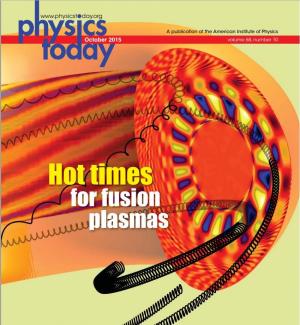Hot times for fusion plasmas
19 Oct 2015
In the October issue of Physics Today, three US researchers report on recent advances in the understanding of wave-particle physics in tokamaks.
In fusion plasmas, interactions between electromagnetic waves and the most energetic ions can perturb ion orbits enough to expel them from the confining magnetic field, resulting in loss of performance. A better understanding of energetic ion behavior in tokamaks is needed to predict and produce the operating parameters required for a fusion reactor.
Based on experiments and simulations of wave-induced ion transport, researchers David Pace (General Atomics), Bill Heidbrink (University of California, Irvine) and Michael Van Zeeland (General Atomics) have supplied new details on the process. Continued development of wave-particle physics will arm researchers with the ability to predict, and then avoid or mitigate, scenarios at ITER in which alpha particles are transported out of their confined orbits in the plasma.
Read the full article at AIP Scitation.


